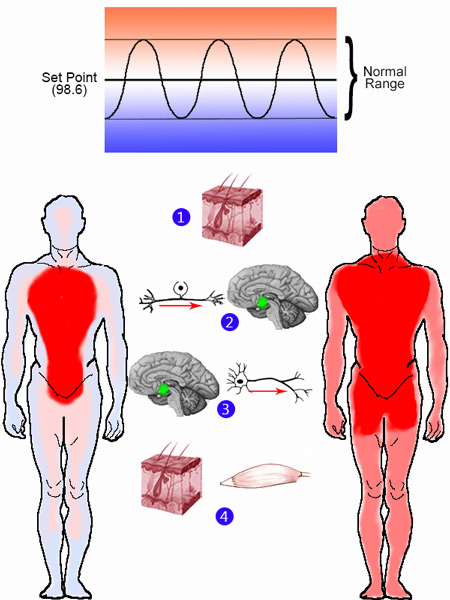HOMEOSTASIS EXPLAINED
HOMEOSTASIS DEFINED
One of the defining features of warm blooded animals like humans is the ability to maintain a core body temperature that is different from the environmental temperature. The average human body temperature is 98.6°F (37°C), and the body exerts a fair amount of energy ensuring that this temperature stays relatively constant; we call this the set point for body temperature. Different set points for different systems are found throughout the body. For instance, the set point for glucose (blood sugar) is 85 mg/dl and the set point for sodium is 142 mmol/L. The body uses a variety of organs and organ systems to help ensure that certain variables remain as close to their set point value as possible, or at least within a normal range. For example, without the assistance of clothing the human body has a remarkable capacity for keeping the variable of body temperature between 98°F and 100°F even when placed in environmental conditions that range from 68°F to 130°F. How does the body stay warm at 68°F and cool at 130°F?
To stay warm, the body can increase metabolism, it can divert blood flow away from the surface, or it can cause muscles to shiver. All of these mechanisms generate heat. Of course we could also use our higher cognitive abilities and put some clothes on. To stay cool, the body releases water droplets on the surface of the skin, forming sweat, which act to dissipate heat as the water evaporates. Perhaps most interesting, is that sweating, shivering, and blood flow diversion happen automatically; in other words, we don't consciously control them, they just seem to happen. This automatic property of the human body to regulate variables was observed and defined by Claude Bernard in 1854. Then in 1926 Walter Cannon named this process homeostasis. Homeostasis, like many scientific words, is of Greek origin were homeo means "similar or same" and stasis means "standing still or remaining the same." Homeostasis then, by definition, is the ability of the body to maintain relatively stable internal conditions (internal environment) even though the outside world (external environment) is changing. The internal environment is defined as the fluid that surrounds the cells.
As will be explained, the human body undergoes a multitude of highly complex interactions to maintain homeostasis by ensuring that systems function to hold different variables within their normal ranges. These interactions are essential to the survival of the body. An inability to maintain homeostasis may lead to death or diseases such as: diabetes, dehydration, hyperthermia, and even allergic reactions.HOMEOSTATIC CONTROL SYSTEMS
In order to explain how homeostasis works, let's revisit changes that occur to maintain body temperature. How does the body know when to shiver or sweat? The first step in recognizing a temperature change is the ability to detect a temperature change. In the body, this function is attributed to a receptor, which is a type of sensor that monitors the environment and detects changes in variables. When conditions cause a change in a variable, we call them stimuli. Once a receptor detects a change, it then communicates this change to a control center. Control centers are located throughout the body, often in the brain, and are responsible for determining the set point and the appropriate course of action to correct deviations from the set point. Control centers dictate a course of action by communicating with effectors. An effector provides the means to correct the deviation. In terms of temperature regulation, the control center is located in the hypothalamus, a small region in the brain, and the effectors would include skeletal muscle (shivering), sweat glands (sweating) and blood vessels. It is also interesting that the human body can change a set point for a particular variable. This change is generally temporary and beneficial. For example, the set point for body temperature can change to a higher value in response to infections, call a fever. This increase in temperature aids the immune system in eliminating the pathogen.
An essential component of homeostasis is communication. Communication in the body occurs primarily through two systems: the nervous system and the endocrine system. Regardless of the system used, if communication flows toward the control center from the receptor, it is termed an afferent pathway. If information flows from the control center to the effector, it is termed an efferent pathway. Collectively, the receptor, afferent pathway, control center, efferent pathway, and effector comprise a homeostatic control system. Essentially all organs and tissues of the body are part of homeostatic control systems and perform functions that help maintain the body's internal environment.

Image modified from public domain images of brain and skin. Other elements freehand by JS at BYU-I 2013.
1. Receptors in the skin and the brain can sense temperature.
2. Information about the temperature travels through afferent neurons to the control center. The control center in this story is the hypothalamus (green dot in the brain picture).
3. The hypothalamus assesses where the temperature is in relationship to set point (98.6). The hypothalamus then sends a signal through efferent neurons to the skin and the muscle tissues.
4. The skin and the muscle tissues are effectors. If the control center determines that the temperature of the body is above set point, then blood vessels in the skin dilate, allowing more blood closer to the surface of the body. Sweat glands in the skin produce more watery sweat that will be secreted on the surface of the skin and allow heat release as the water is evaporated. If the control center determines that the temperature of the body is below set point, then the blood vessels of the skin constrict to keep warm blood towards the core of the body. Also, sweat glands cease producing sweat. Muscles are another effector when it is cold. Muscles begin to shiver, which produces heat in the body.
**You may use the buttons below to go to the next or previous reading in this Module**


